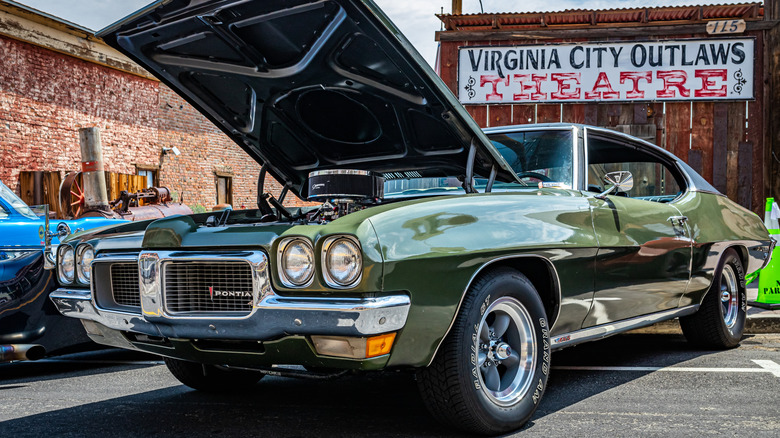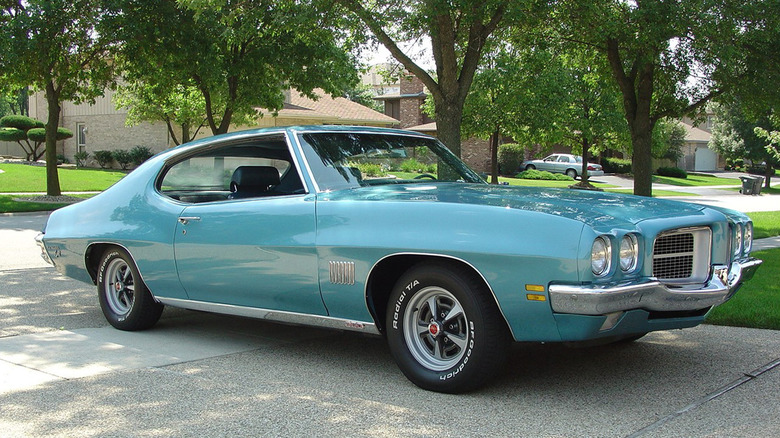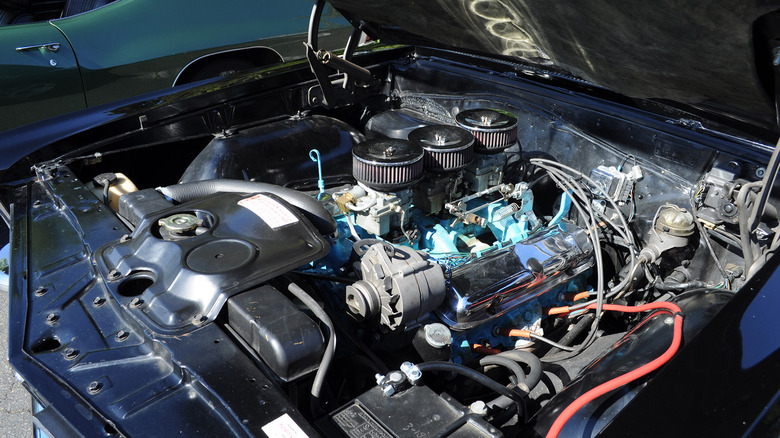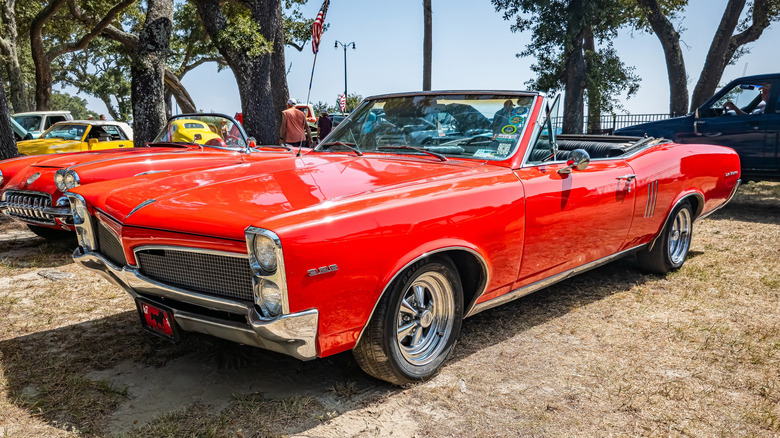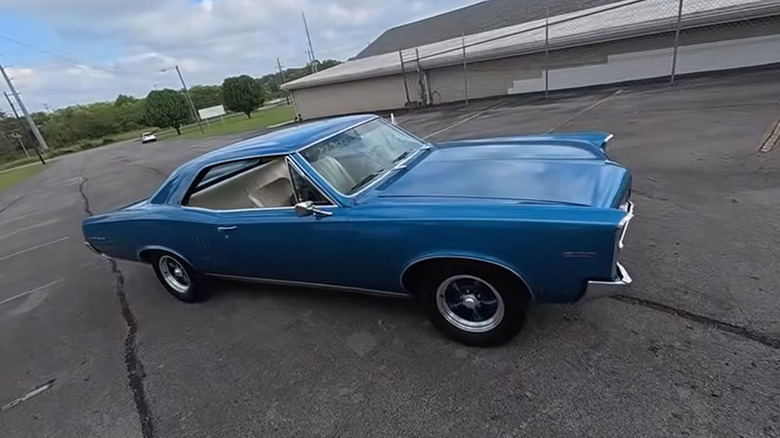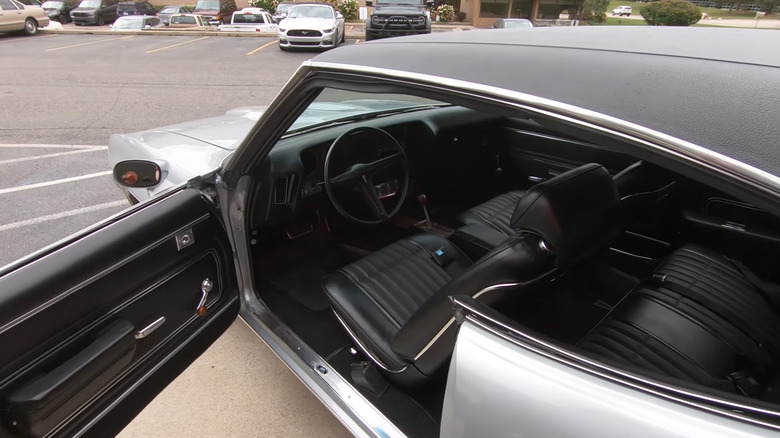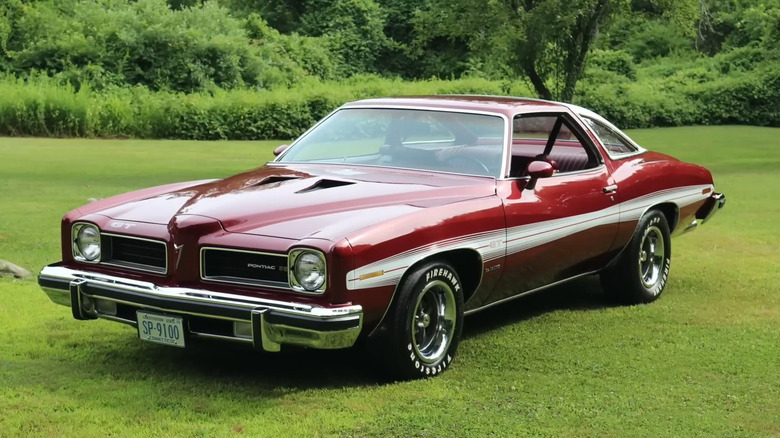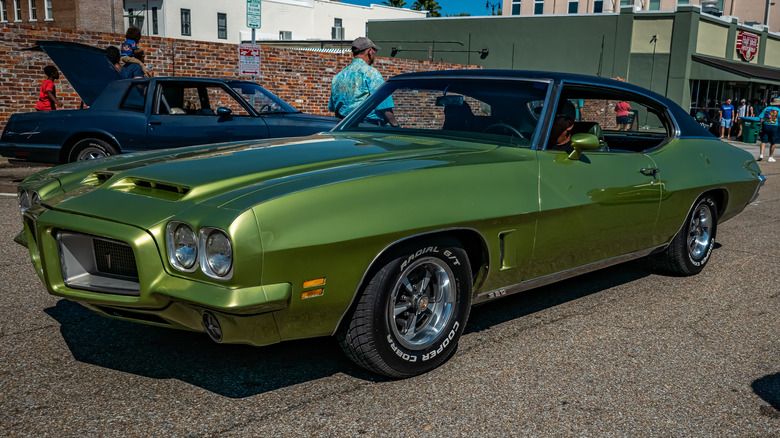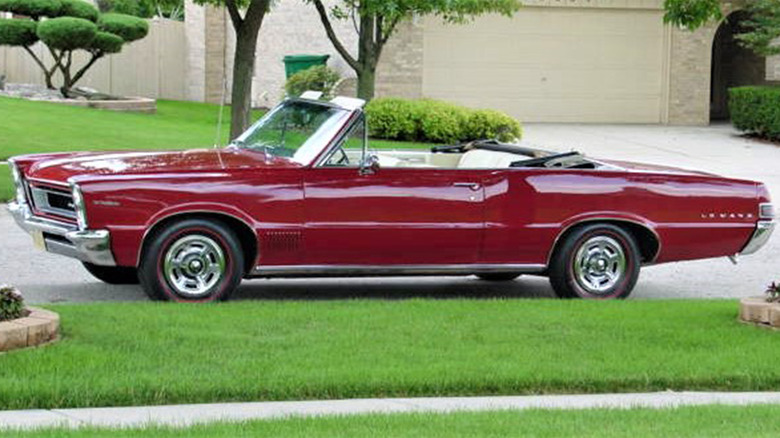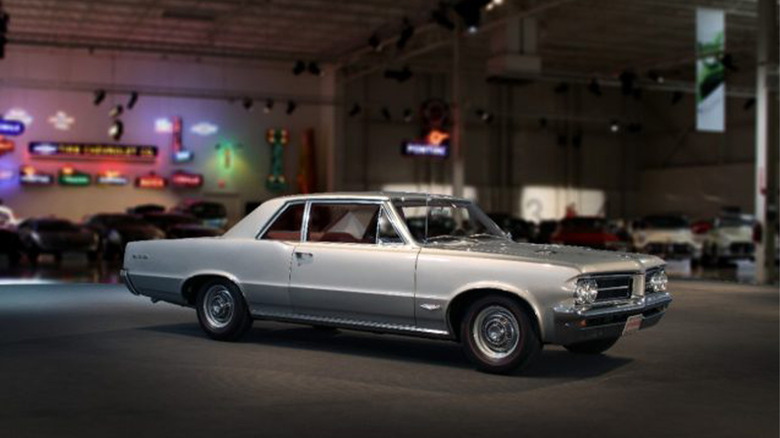10 Reasons A Classic Pontiac LeMans Is Still Worth Buying Today
Pontiac made some seriously cool muscle cars when it was still in business. You've no doubt heard about the Firebird, GTO Judge, Trans Am, and Grand Am — Pontiac made these cars to compete with other American car brands in the 1960s and '70s. It continued to compete until its demise during GM's Chapter 11 reorganization that took place in 2009. Among the cool stuff that Pontiac made was a lesser-known and less popular car named after the oldest and greatest race, the 24 Hours of Le Mans.
The Pontiac LeMans was never the biggest product in Pontiac's portfolio, but it was arguably one of the most important. It was originally a trim level on the Pontiac Tempest before becoming its own nameplate in 1963. In addition, the GTO started out as a performance package on the LeMans before becoming its own model in 1966. So, while the LeMans is often overlooked in Pontiac's muscle car lineup, it was right in the thick of the action when things really got going. That makes it just as much of a collector car as any other Pontiac from back then.
If the LeMans interests you, there are plenty of reasons to consider one. It has one of the more entertaining histories of any muscle car from that era, up to and including it being named after the 24 Hours of Le Mans. Between its customization, various body styles, and more, the LeMans is a perfectly serviceable classic car that'll still turn heads even if it's not something more well-known, like a Mustang or a Corvette.
The LeMans has several body styles to choose from
The Pontiac LeMans was a chameleon car in many ways. Like the classic Pontiac Firebird, it was one of the first widely popular models with the muscle car aesthetic that people know and love. However, it had several other body styles over the course of its long run as well. As such, if you're looking for something classic that had a bit of a different vibe from the classic muscle car while still wanting a car from that era, the LeMans may be for you.
There are several examples to choose from. The early 1960s LeMans, back when it was still a trim level on the Tempest, was boxier and more angular than the smoother, curvier muscle cars that would start popping up. Pontiac would go back to that again in the 1970s with the long front end and an even boxier shape. That styling would last into the 1980s, when the LeMans was officially discontinued.
Technically speaking, Pontiac brought back the nameplate in the 1990s as well. By this point, GM was shipping Korean-made cars to the states to see if they would sell, and the brand would slap classic names like LeMans onto the cars to help them sell better. These, of course, are a far cry from the LeMans of the 1960s and '70s. However, they are still Pontiac LeMans and their small sedan shape may appeal to fans of similar cars from that era.
[Featured image by Tripower65 via Wikimedia Commons | Cropped and scaled | CC BY-SA 4.0]
Some models had the legendary Pontiac 389
Pontiac was stuffing excellent engines into many of its cars during the 1960s and 70s, and the LeMans was no different. Over the course of its heyday, the car came with a variety of engines to choose from. They include Pontiac's 326 V8, the 389 V8, a 140 horsepower inline-six, and several others over the years. So, if you're shopping for a LeMans, you get plenty of options when it comes to stock powertrains.
The most notable of the bunch is Pontiac's excellent 389 V8. Pontiac used this engine in a variety of cars in the early 1960s and the LeMans was no different. It was a versatile engine and could produce anywhere from 215 to 425 horsepower depending on how it was tuned at the factory. Thus, it is possible to get a Pontiac LeMans that could get up and go when you wanted it to. The 389 is a proven winner, having won 30 out of the 54 NASCAR Grand National the car engine appeared in during the 1960 and '61 seasons.
Admittedly, finding a LeMans with the 389 is tough because it was offered as an optional engine. However, it is entirely possible to buy a Pontiac LeMans, find a Pontiac 389 somewhere, and drop the engine in. It definitely fits considering that the car was capable of running the engine out of the factory. Those who want a faster LeMans should look into opting for that particular engine.
[Featured image by Joe Mabel via Wikimedia Commons | Cropped and scaled | CC BY-SA 4.0]
It was also great for date nights
For those who want a car for cruising more than racing, the LeMans is still a good choice. Pontiac positioned the LeMans as one of the more luxury-oriented vehicles in its lineup, so compared to many of its competitors, the interior space and drivability is relatively posh compared to performance-oriented cars of the day. Plus, some of the models looked positively stately, especially with the aforementioned boxy designs of the early 1960s and most of the 1970s. With the right color options and interior choices, it looked like something an important person would drive.
In some model years, the car was nice enough to draw parallels to BMW. The car's midsize stature made it easygoing to drive while still providing enough space in the front and back rows for family outings and cruising around on date night. In fact, when Pontiac went bigger in the 1970s, BMW swooped in and took the midsize semi-luxury segment with a car that was of similar dimensions to older Pontiac LeMans model years.
In short, if you're looking for a classic car to buy and restore for the purpose of showing off at car shows and cruising around town on warm summer evenings, the LeMans fits the bill. Most of its models look good with handsome styling along with engine and suspension options that made it a pleasant cruiser. That means you can build a LeMans to be fast or to be chill. The choice is yours, since the LeMans can do both.
They aren't too expensive
Many classic cars have sky-high price tags, and rightfully so. Ford Mustangs are super popular, so a fully restored one can easily go for six digits, especially with the most desirable engines and configurations. Since the LeMans doesn't have the same level of name recognition as some of the more popular classic cars from the era, its prices tend to stay within the range of being generally affordable. You can find a Pontiac LeMans from the 1960s or '70s in reasonably good condition for anywhere from $25,000 to $50,000 in most cases.
There are exceptions to the rule, though. Some enterprising individuals have fully restored cars while adding a plethora of modern upgrades and modifications that drive prices much higher. One example is a 1970 Pontiac LeMans we found on Autotrader that ran for $105,998. It was far from a stock vehicle with upgraded HID headlights, a completely custom red interior that matched the red paint job, a push button start, and other modern amenities. These are out of the ordinary for the LeMans when you shop for it used.
The other nice part of shopping for a LeMans is that there are plenty of them from across the nameplate's history. We were able to quickly and reliably find models from the 1960s and 1970s that were in a large range of prices. The air gets a bit thin toward the end of the car's run, so a 1980s LeMans is a little more difficult to find but they are out there if you really want one.
You have options during restoration
If you decide to go the more affordable route and buy a Pontiac LeMans that needs some love, you're in for a decent time. It's no more or less difficult to restore than any other classic car. In fact, since it was a GM product and closely connected to two other nameplates — the Tempest and the GTO — you actually have a lot of options when it comes to restoring an old LeMans.
Let's talk engines. As previously mentioned, the LeMans came with several engines over the span of its history, and you can choose between them for your LeMans restoration. If those options aren't good enough, there is a small but dedicated segment of the LeMans owners who have swapped their engines out for Chevy small block V8s. Once you get one of those in there, the sky is the limit for modifications. In one example from Reddit, an owner put a Chevy small block in a 1966 Pontiac LeMans with a Holley Carburetor. It made somewhere around 525 horsepower.
Fortunately, third-party parts makers have essentially all the parts you'd need for an engine swap, so it's not terribly difficult to rebuild the LeMans from the frame out with whatever Pontiac or Chevy small block V8 engine that you want. It's especially a fun option if you want a sleeper racer, since the LeMans wasn't well known for being particularly fast outside of the GTO trim level.
It's named after the 24 Hours of Le Mans
One of the coolest things about the Pontiac LeMans is its namesake, the legendary 24 Hours at Le Mans. The most important part of this is the pronunciation. When you pronounce the car, you make sure to include the S sound at the end, whereas the name of the race keeps the S silent. The 24 Hours at Le Mans race is the oldest — and arguably best-known active endurance race in all of racing, and it's where automakers go to test the very limits of their engineering.
To be fair, Pontiac's use of the name here is a little suspect. Pontiac as a brand has never won at Le Mans, so the name here is honorary only. Somewhat ironically, Pontiac rarely built the LeMans for speed, with the GTO trim being the only notable example — until, of course, that too was spun off into its own car. That said, the Pontiac LeMans did win its fair share of races in America. In fact, the 1963 LeMans won the NASCAR Challenge Cup from that same year.
Still, fans of the 24 Hours of LeMans can pick up a Pontiac LeMans to get in on the name a little bit. Of course, a better option might be the Ford GT that actually won the LeMans in the late 1960s. However, those can go for millions of dollars, especially if faithfully recreated like the cars that won the race. A Pontiac LeMans is a nice way to honor the name while also not destroying your wallet.
Some LeMans are quite rare
Those who fancy rarer cars can still take a good look at the Pontiac LeMans. For the most part, the LeMans is not a rare car. You can find examples from most model years without too much difficulty. However, some model years had some trims that are a little more difficult to get one's hands on. In most cases, it's because people simply aren't selling them. For example, Classic.com lists only two 1971 Pontiac LeMans currently for sale with only 14 sold over the last decade.
If you're looking for LeMans that are rare because there aren't a lot of them, you have options there too. Perhaps the best example is the 1974 Pontiac LeMans GT. Models that still used the A-style body with a four-speed transmission and a front bench seat are exceedingly rare, with only 285 examples ever produced. Good luck finding one as they don't go on sale very often. During this time, Pontiac was shifting the LeMans to the new X-style body that was also being used by other GM brands for vehicles, so the A-style body wasn't used much that year.
Another good example is the 1963 Pontiac LeMans. Pontiac included some good engine options on the 1963 model, but one that you don't see often is the Pontiac 421 V8. Only six 1963 Pontiac LeMans were made with the 421 V8 stock from the factory. If you can get your hands on one, you'll have one of the rarest Pontiac vehicles ever made.
You can use them to make your own GTO
Aftermarket car modifications are fairly common and popular in the classic car scene. Usually the modifications are to make cars look like ones they saw in movies. For example, some folks might find a Trans Am and modify it to be like the Bandit Trans Am in the movie "Smokey and the Bandit." Potential LeMans owners can do this as well, albeit in a slightly different way. Since the GTO was born from the LeMans, you can actually turn a LeMans into a GTO with a few modifications.
The biggest change is going to be seen in the engine bay. However, since every Pontiac V8 from the 1960s fits into a 1960s Pontiac LeMans, finding the right engine is no trouble. That said, it does require quite a bit of modification under the hood. From there, it's just finding a GTO or a seller of GTO parts to get the various body trim pieces and other accoutrements. Once it's all pieced together, you'll have a GTO clone. This is something a number of LeMans owners have done in the past so there is plenty of information for people who want to do it.
However, this is one of those things we don't necessarily recommend. After all, the LeMans is a pretty nice car in its own right and collectors have rightfully pointed out that LeMans aren't exactly growing on trees, which means they're getting rarer by the year. Even so, the fact that it's an option gives the LeMans another level of customization that many other muscle cars don't have.
Some come with a convertible
We've already talked about how to make the LeMans faster as a drag car or more luxurious as a cruiser. However, one thing we didn't mention was that many of the model years came with a convertible. For every year the LeMans was available in the 1960s, there was an option for a convertible top. That trend continued until 1972, ending with the 1973 model year.
So, to further the notion that the LeMans is arguably best used as a cruiser, look no further than a convertible version of the car. There are pros and cons to this, of course. After all, a convertible top is another moving part that can break down and the tops themselves can leak and cause other issues. However, many people put their classic cars in the garage during inclement weather, so there's less of a chance of that happening with your LeMans.
What you get in return is that old school feeling of driving around on a warm evening with the top down and the wind through your hair. Of course, a large portion of popular cars from the 1960s had convertible variants, but you can add the LeMans to the list of ultimate cruiser convertibles and that's yet another good reason to consider picking one up.
[Featured image by Tripower65 via Wikimedia Commons | Cropped and scaled | CC BY-SA 4.0]
You can own a part of history
Arguably the coolest part of the LeMans is its place in American muscle car history and it's a pretty neat story. In the early 1960s, Pontiac was making the Pontiac Tempest and gave it a trim level known as the Tempest LeMans. In 1964, Pontiac would give the LeMans its own nameplate. In the prior years, the LeMans was the high-performance version of the Tempest, sporting Pontiac's best engines. In 1964, the LeMans would receive its own nameplate and become its own car.
That same year, Pontiac released what GM refers to as the 1964 Pontiac Tempest LeMans GTO. This name is amazing because all three of those names would go on to become their own vehicles in Pontiac's lineup. For that year, though, it was a Tempest LeMans with the GTO package, and it is widely regarded as the first American muscle car. In 1966, the GTO would become a standalone model, divorcing itself from the LeMans and Tempest names to become Pontiac's de facto muscle car. Meanwhile, the LeMans would take a backseat and become the luxury-oriented cruiser that it would continue to be until it was discontinued in the 1980s.
So, if you fancy yourself a muscle car history buff, a 1964 Pontiac Tempest LeMans GTO is the car for you. It was the start of the muscle car revolution and, as you can plainly see, the LeMans was right in the thick of it. It wasn't its own car yet so technically you're buying a Tempest and not a LeMans. However, the name is there, so it counts. The Tempest, LeMans, and GTO together made up the first muscle car.
